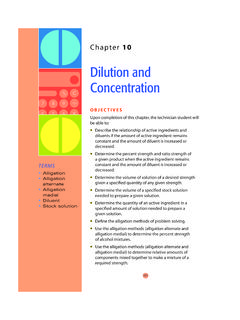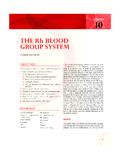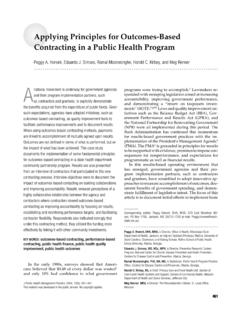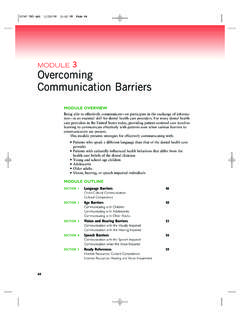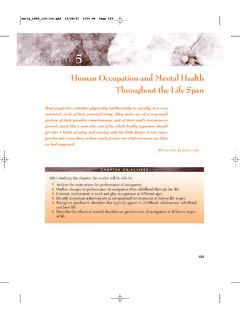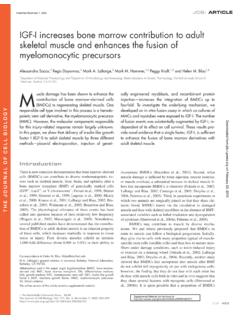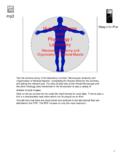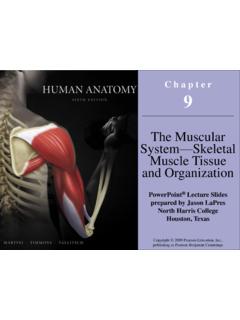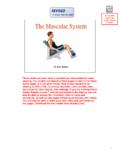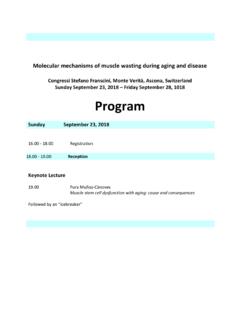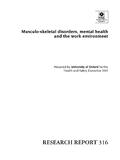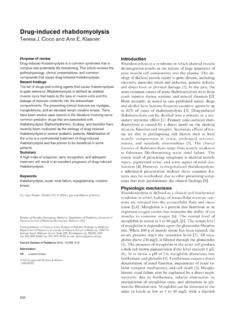Transcription of Biomechanics of Skeletal Muscle
1 STRUCTURE OF Skeletal Muscle ..46 Structure of an Individual Muscle Fiber ..46 The Connective Tissue System within the Muscle Belly ..48 FACTORS THAT INFLUENCE A Muscle S ABILITY TO PRODUCE A MOTION ..48 Effect of Fiber Length on Joint Excursion ..48 Effect of Muscle Moment Arms on Joint Excursion ..50 Joint Excursion as a Function of Both Fiber Length and the Anatomical Moment Arm of a Muscle ..51 FACTORS THAT INFLUENCE A Muscle S STRENGTH ..52 Muscle Size and Its Effect on Force Production.
2 52 Relationship between Force Production and Instantaneous Muscle Length (Stretch) ..53 Relationship between a Muscle s Moment Arm and Its Force Production ..56 Relationship between Force Production and Contraction Velocity ..58 Relationship between Force Production and Level of Recruitment of Motor Units within the Muscle ..60 Relationship between Force Production and Fiber Type ..61 ADAPTATION OF Muscle TO ALTERED FUNCTION ..62 Adaptation of Muscle to Prolonged Length Changes ..62 Adaptations of Muscle to Sustained Changes in Activity Level.
3 63 SUMMARY ..64 Biomechanics of Skeletal Muscle4 CHAPTERCHAPTER CONTENTS45 Skeletal Muscle is a fascinating biological tissue able to transform chemical energy to mechanical energy. Thefocus of this chapter is on the mechanical behavior of Skeletal Muscle as it contributes to function and dysfunc-tion of the musculoskeletal system. Although a basic understanding of the energy transformation from chemi-cal to mechanical energy is essential to a full understanding of the behavior of Muscle , it is beyond the scope of thisbook.
4 The reader is urged to consult other sources for a discussion of the chemical and physiological interactions thatproduce and affect a Muscle contraction [41,52,86]. Skeletal Muscle has three basic performance parameters that describe its function: Movement production Force production EnduranceThe production of movement and force is the mechanical outcome of Skeletal Muscle contraction. The factors thatinfluence these parameters are the focus of this chapter. A brief description of the morphology of muscles and 4/18/07 2:21 PM Page 4546 Part I | BIOMECHANICAL PRINCIPLES belly consists of the Muscle cells, or fibers, that produce thecontraction and the connective tissue encasing the musclefibers.
5 Each is discussed of an Individual Muscle FiberA Skeletal Muscle fiber is a long cylindrical, multinucleatedcell that is filled with smaller units of filaments (Fig. ). TheseSTRUCTURE OF Skeletal MUSCLEThe functional unit that produces motion at a joint consistsof two discrete units, the Muscle belly and the tendon thatbinds the Muscle belly to the bone. The structure of the mus-cle belly itself is presented in the current chapter. The struc-ture and mechanical properties of the tendon, composed ofconnective tissue, are presented in Chapter 6.
6 The musclephysiological processes that produce contraction needed to understand these mechanical parameters are also presentedhere. Specifically the purposes of this chapter are to Review briefly the structure of Muscle and the mechanism of Skeletal Muscle contraction Examine the factors that influence a Muscle s ability to produce a motion Examine the factors that influence a Muscle s ability to produce force Consider how Muscle architecture is specialized to optimize a Muscle s ability to produce force or joint motion Demonstrate how an understanding of these factors can be used clinically to optimize a person s performance
7 Discuss the adaptations that Muscle undergoes with prolonged changes in length and activityBiceps brachii Muscle (Biceps brachii m.) Muscle fiberMyosin myofilamentSingle myofibrilActin myofilamentMuscle fascicleFigure :Organization of Muscle . A progressively magnified view of a whole Muscle demonstrates the organization of the filamentscomposing the 4/18/07 2:21 PM Page 4647 Chapter 4 | Biomechanics OF Skeletal Muscle chains to slide on the myosin chain (Fig. ). The tension ofthe contraction depends upon the number of cross-bridgesformed between the actin and myosin myofilaments.
8 The num-ber of cross-bridges formed depends not only on the abun-dance of the actin and myosin molecules, but also on thefrequency of the stimulus to form is initiated by an electrical stimulus from theassociated motor neuron causing depolarization of the musclefiber. When the fiber is depolarized, calcium is released intothe cell and binds with the regulating protein troponin. Thecombination of calcium with troponin acts as a trigger, caus-ing actin to bind with myosin, beginning the of the nerve s stimulus causes a reduction in cal-cium levels within the Muscle fiber, inhibiting the cross-bridges between actin and myosin.
9 The Muscle relaxes [86]. IfHActinMyosinZ-lineZ-lineAZ-lineISarcom ereAHFigure : Organization of actin and myosin within a musclefiber. The arrangement of the actin and myosin chains in twoadjacent sarcomeres within a fiber produces the characteristicstriations of Skeletal structures are roughly aligned parallel to the mus-cle fiber itself. The largest of the filaments is the myofibril,composed of subunits called sarcomeresthat are arranged endto end the length of the myofibril. Each sarcomere also con-tains filaments, known as myofilaments.
10 There are two types ofmyofilaments within each sarcomere. The thicker myofila-ments are composed of myosin protein molecules, and thethinner myofilaments are composed of molecules of the pro-tein actin. Sliding of the actin myofilament on the myosinchain is the basic mechanism of Muscle SLIDING FILAMENT THEORY OF MUSCLECONTRACTIONThe sarcomere, containing the contractile proteins actin andmyosin, is the basic functional unit of Muscle . Contraction of awhole Muscle is actually the sum of singular contraction eventsoccurring within the individual sarcomeres.
